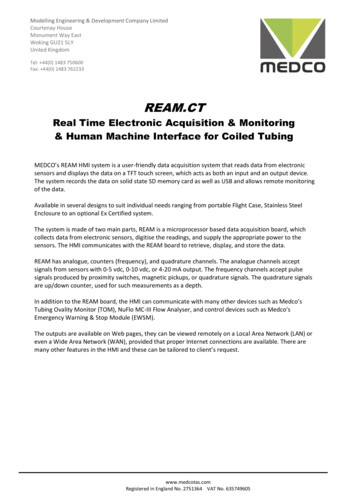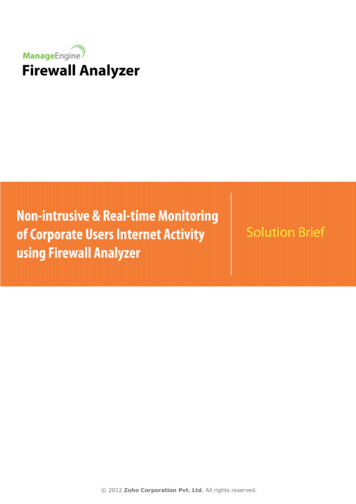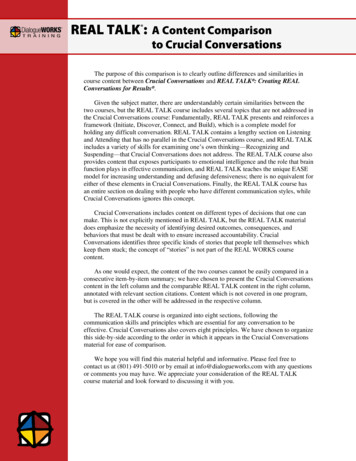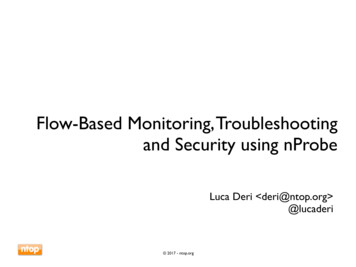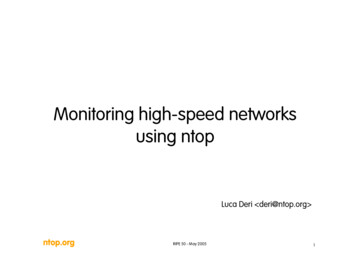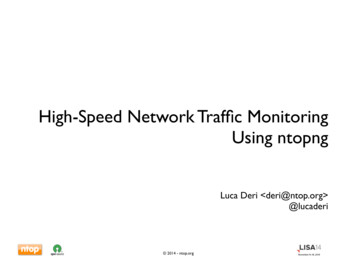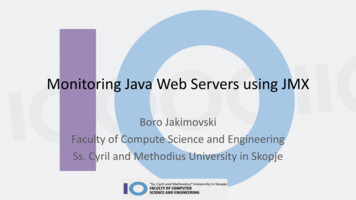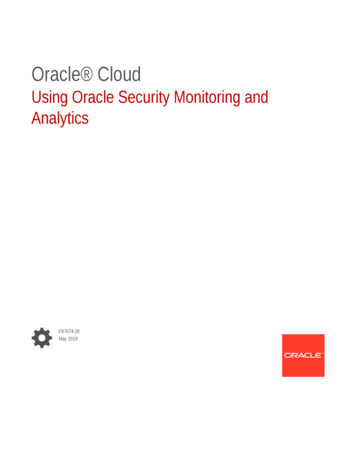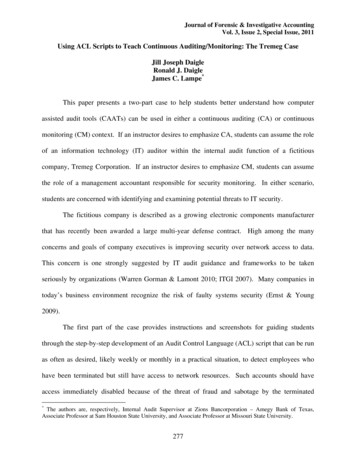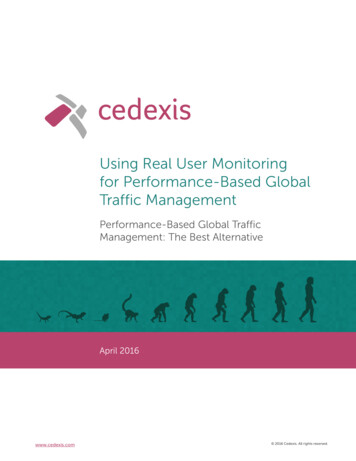
Transcription
Using Real User Monitoringfor Performance-Based GlobalTraffic ManagementPerformance-Based Global TrafficManagement: The Best AlternativeApril 2016www.cedexis.com 2016 Cedexis. All rights reserved.
USING REAL USER MONITORING FORPERFORMANCE-BASED GLOBAL TRAFFIC MANAGEMENTTable of ContentsThe Evolution of Content Delivery.3Why Round-Robin Doesn’t Fly. 4Geographic Load Balancing: Routing with the Wrong Data.5Latency Changes Over Time. Geography Doesn’t. 6Performance-Based Load Balancing: Routing with Real Data.7Synthetic Monitoring: No Substitute for the Real Thing.7RUM: Real User Measurements Reveal the User Experience.8The Need for Speed.92www.cedexis.com 2016 Cedexis. All rights reserved.
USING REAL USER MONITORING FORPERFORMANCE-BASED GLOBAL TRAFFIC MANAGEMENTThe Evolution of Content DeliveryIn sports, the only statistic that really matters is who scores the most points by theend of the game. On the Internet, speed is how you win with customers.There is an evolution happening in content delivery optimization. Just as NPM andAPM revolutionized WAN and LAN traffic, quality of experience (QoE) monitoringis changing the way we deliver Internet applications. Static options served well incontrolled network environments, but the unpredictable performance of the Internetrequires a more intelligent approach to global traffic management.Only Cedexis performance-based load balancing leverages billions ofmeasurements, collected daily from 45,000 ISPs around the globe.You want to be fast no matter where in the world your clients are. Ensuring a speedy,consistent user experience across a best-effort network becomes increasinglychallenging as traffic increases globally. Several global traffic managementapproaches attempt to tackle this problem, but only one of them succeeds.3www.cedexis.com 2016 Cedexis. All rights reserved.
USING REAL USER MONITORING FORPERFORMANCE-BASED GLOBAL TRAFFIC MANAGEMENTWhy Round-Robin Doesn’t FlyThe easiest type of load balancing is round-robin. This method distributes trafficmore or less randomly by directing each user to the next available origin or CDN.Each content source ends up handling an equal amount of traffic.As traffic needs grow and become more geographically diverse, round-robin’s faultsbecome painfully clear. With no awareness of a user’s location or network conditions,round-robin is just as likely to route a user to a high-latency origin as a low-latency one.Round RobinRound-robin global load balancing uses a more or less random methodof directing a user to a content provider.Drawbacks Indiscriminate when routing users to content sources. No knowledge of network or system performance. Naive routing algorithm leads to a bad user experience.Round-robin does not use any performance data for decision making. Itblindly makes routing decisions.4www.cedexis.com 2016 Cedexis. All rights reserved.
USING REAL USER MONITORING FORPERFORMANCE-BASED GLOBAL TRAFFIC MANAGEMENTGeographic Load Balancing: Routing with the Wrong DataIP address geolocation gives us the ability to narrow down the physical locationof a user by region. Geographic load balancing routes users to the contentsource physically closest to them. Theidea seems sound at first: to minimizelatency, traffic is directed toward theclosest geographic content source.Different origins deliver a drastically different QoEto each user. Figuring out the correct origin iswhat latency-based load-balancing is all about.Geographic Load BalancingWith geographicload balancing,traffic is routed tothe source physicallyclosest to theuser. This methodfails because ofthe complexity ofInternet routing.Drawbacks Network topology doesn’t conform to geography. Different networks have different peering relationships, routing paths, andperformance difficulties. Outages, oversaturation, or routing issues are not taken into account. It fails to measure the most important metric: the end-user experience.It’s not uncommon for a route based on geographic analysis to perform farworse than expected. Speed defines end user experience, not proximity.5www.cedexis.com 2016 Cedexis. All rights reserved.
USING REAL USER MONITORING FORPERFORMANCE-BASED GLOBAL TRAFFIC MANAGEMENTAverage Network LatencyThese two graphs reflect average latency for a 12-hour periodfor end users in a distinct geographic region of the UnitedStates. Since they measure latency, lower numbers meanmore speed. For CenturyLink, AWS EC2 provides a betterconnection, but for Charter Communications, SoftLayer is thebetter option. Each cloud service provides a different quality ofexperience for the same geographic region. This shows one ofthe biggest drawbacks of geographic load balancing.Latency Changes Over Time. Geography Doesn’t.Because Internet infrastructure is constantly changing, your end-user performanceis a moving target. Traffic across a content delivery route will lose quality at amoment’s notice. Congestion comes and goes unpredictably within regions,causing latency road bumps that are overlooked when looking at averages.Geographic load balancing can’t detect this, much less mitigate it.Geographic load balancing doesn’t solve the problem. The only way to reliablydeliver fast, reliable content is by measuring the actual user experience.Unpredictable changes in network performance mean that at any point in time,different content providers will see variations in latency to geographic regions.6www.cedexis.com 2016 Cedexis. All rights reserved.
USING REAL USER MONITORING FORPERFORMANCE-BASED GLOBAL TRAFFIC MANAGEMENTPerformance-Based Load Balancing: Routing with Real DataGeographic load-balancing routes traffic based on assumptions that aren’t backed byany performance data. Effective global traffic management reduces the guesswork bymeasuring network performance and routing users to content sources that performthe best for them at that specific time. This is the goal of performance-based loadbalancing. Synthetic monitoring and real user measurements (RUM) are the twodifferent methods of performance-based load-balancing.Synthetic Monitoring: No Substitute for the Real ThingSynthetic monitoring measures performance between public-facing ISP serversand popular content providers. It fails to take into account the last mile, the largenumber of factors that affect performance between the ISP and the end user.Synthetic MonitoringBy failing to collect enough measurements and take the last mile into account,synthetic monitoring suffers from a number of disadvantages.Disadvantages Monitoring agents fail to be representative of the end-user experience. Fewer agents means the measurements miss the vast majority ofnetwork routes. Poor modeling of the user experience produces unrealistic results.Collecting data only at major centers and only for generic requests does notprovide the whole story. Routing decisions do not reflect network reality.7www.cedexis.com 2016 Cedexis. All rights reserved.
USING REAL USER MONITORING FORPERFORMANCE-BASED GLOBAL TRAFFIC MANAGEMENTRUM: Real User Measurements Reveal the User ExperienceThe true key to effective andconsistent performance-Synthetic metrics are not complete metrics, and load balancing based on them willbased global load balancingnot be ideal. The true key to effective and consistent performance-based global loadis real end-user data.balancing is real end-user data. Without knowing the actual latency from the contentsource to the user, it’s simply guesswork.RUM vs. Synthetic Page Load TimesAny performance-basedglobal load balancingneeds an aggregate ofRUM page load times showmeasurements typically two tothree times slower than syntheticmeasurements, providing amuch more realistic view ofthe end user’s experience.(Source: “Comparing RUM & SyntheticPage Load Times” by Steve Souders)RUM data. How big doesthis aggregate need to beto be effective? Huge.Discovering the true latency requires measurements between actual users and contentproviders: true RUM. Any performance-based global load balancing needs an aggregateof RUM data. How big does this aggregate need to be to be effective? Huge.Approximately thirty thousand networks, or sixty percent of ASNs, have multipleA RUM system needsupstream providers. This means that with an equal distribution of measurements, oneto collect billions ofmillion RUM data points per day will give you only thirty-three measurements per ASN,measurements per dayor barely more than one per hour. With traffic spread unevenly across ASNs, a RUMto provide accurate,up-to-date performancesystem needs to collect billions of measurements per day to provide accurate, up-information.to-date performance information. RUM solutions without this much traffic will fail toprotect you from poor performance across networks with less traffic.Using RUM isn’t as simple as just collecting it. Data needs to be processedand identified as useful before it’s put to work. In fact, up to 40% of RUMmetrics collected by Cedexis Radar end up discarded.8www.cedexis.com 2016 Cedexis. All rights reserved.
USING REAL USER MONITORING FORPERFORMANCE-BASED GLOBAL TRAFFIC MANAGEMENTReal User Measurements: RUMTrue performance-based global traffic management requires realistic data thatis as current and comprehensive as possible. This means monitoring networkperformance from actual end-user devices: Real User Measurements.Advantages RUM measures the real performance of content providers across the lastmile of end-user connectivity. Data is transparent and unobtrusive. RUM metrics are global, across thousands of relevant ASNs. Routing decisions are based on real-time information, including networkservice interruptions and performance.RUM is the only method that pays attention to the single metric that mattersto your end-users: speed.The Need for SpeedNatural selection on the Internetselects the service that can givetheir users speedy, responsivecontent. We are evolving performance-based global traffic management based onuser data to bring our clients to the top of their industry.To improve the only statistic that matters, load-balancing decisions need to beinformed by relevant data. Cedexis RUM is the real-world information that givesperformance-based global load balancing the key.9www.cedexis.com 2016 Cedexis. All rights reserved.
USING REAL USER MONITORING FORPERFORMANCE-BASED GLOBAL TRAFFIC MANAGEMENTKey PerformanceIndicators for the WebWhile download speed isimportant, it isn’t the onlyperformance metric thatimpacts performance.Here are some other keyperformance indicatorsto watch for. Properlydesigned load balancingcan enhance all aspects ofcontent delivery. Latency can delaynetwork traffic and cancancel out the benefitsof speed. Availability is crucial,and even the fastestspeeds are meaninglesswithout it. Buffering kills videoon-demand andencourages end userabandonment.Customers abandon Internet activities quickly when things start to slow down. Speed matters.Learn how to use performance-based global traffic managementto give your web application the key to speed. Visit our website tolearn more about Cedexis Radar and Openmix.All of these metrics feedinto the overall customerquality of experience (QoE).With deep experience in delivery networks and performance optimization,Cedexis is the global expert in multi-cloud and multi-CDN strategies. Today,over 500 media, retail, luxury, and consumer brands count on Cedexis for100 percent availability, optimal Web performance, flexibility, and choicethat drives revenue and lowers cost and risk.Portland, OregonParis, France317 SW Alder St, #65027 rue Raymond LefebvrePortland, OR 9720494250 Gentilly, France 1 855 CEDEXIS (233-3947) 33 (0)1 79 755 253visit cedexis.com or email sales@cedexis.com.10www.cedexis.com 2016 Cedexis. All rights reserved.
Geographic load balancing can’t detect this, much less mitigate it. Geographic load balancing doesn’t solve the problem. The only way to reliably . connection, but for Charter Communications, SoftLayer is the better option. Each cloud service provides a different quality of exp
